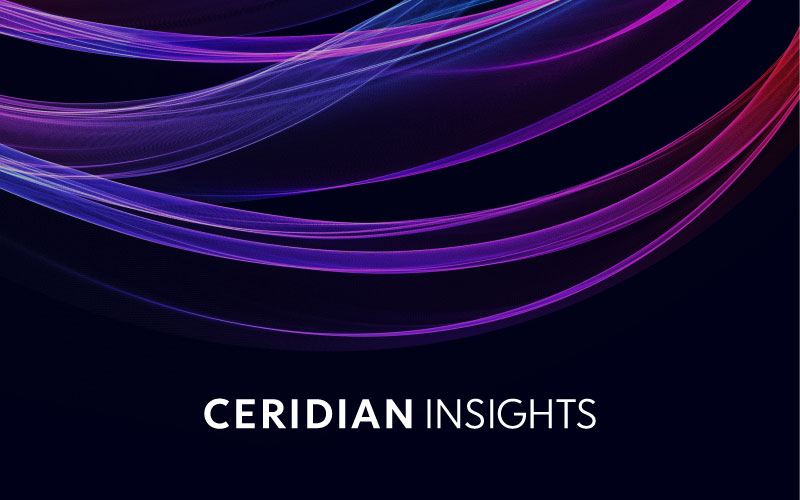A vision for Intelligence at work
Ceridian CEO David Ossip, CTO Joe Korngiebel, and Head of Asia Pacific Japan Stephen Moore, along with Sue Sterjovski from Australian media conglomerate News Corp, discussed what the future of work will look like, and how people, companies, and technology will come together to make it possible.

Table of Contents
What if the workplace of the future isn’t a workplace at all? Why do pay periods still exist? Our lives are on-demand, why isn’t our pay?
These are some of the questions Ceridian CEO David Ossip challenged attendees to ponder during the INSIGHTS 2020 opening keynote at Ceridian’s virtual conference.
Along with new CTO Joe Korngiebel and President and Head of Asia Pacific Japan Stephen Moore, Ossip shared key workplace trends and a future state for leaders, employees, and businesses.
WATCH NOW: Vision keynote: Ceridian’s vision for Intelligence at work
The new work experience: fluid, on-demand
What does the future of work look like? Borderless. Skills-based. Fluid. Augmented. On-demand.
And to make it possible, technology and the employee experience must come together to enable workers, work experiences, and business agility for that future.
It means that leaders need to solve for new types of challenges as they build the foundation for an increasingly elastic workforce.
For example, while the instant world has created options for today’s workers when it comes to where and when they work, it’s also led to increased liquidity challenges for those workers, whether salaried, hourly, contract, or gig, Ossip said. This creates a cash flow crunch for employees between pay days, and they often turn to credit cards or payday loans to bridge the gap.
That’s where solutions like Ceridian’s Dayforce Wallet (APJ launch TBD) come in. It’s a flexible on-demand pay solution.
“On-demand pay is now a fundamental workplace requirement,” Ossip said. The traditional pay period is an artifact of 1940’s batch-based technology, he added. “In every other aspect of our lives, we’re accustomed to instant delivery,” Ossip said, and the same should apply to getting paid.
With Dayforce Wallet, employees can see their net earnings (including taxes and deductions) at the end of every day or shift, and can choose to get paid immediately. There’s no fee for employees or software subscription fee for employers. Payroll admins don’t have to change how they process payroll, and there are also no changes to how payroll is funded.
Ossip shared an example from Buehler’s Fresh Foods to show how continuous access to pay contributes to improving employee well-being and employer competitive advantage: Watch the story here.
Learn more about breaking the payday paradigm in our Reimagining payday white paper
Looking ahead, Ossip talked more about what the future of work will look like, powered by an elastic workforce – and Dayforce. He envisions an infrastructure that empowers people to choose where and when they work, with Dayforce as the platform that holds worker identity and HR information, skills, experience, and verification. With this structure, employees could work for any workplace without the need for on- or off-boarding, and be paid as soon as work is completed.
He likened this skills-based, project-based world of work to other industries, like gaming, in which, depending on the timing and type of game, teams form and dissolve fluidly, and are dependent on skillsets.
“To enable the workplace of the future, we will match skills and work in a more intelligent way,” Ossip said.
Ceridian’s history of innovation and vision for the future
Early in his keynote, Ossip outlined Ceridian’s track record as an innovator in human capital management. In 2020 alone, he added, Ceridian launched several new and game-changing products, including Dayforce Wallet, Employee Safety Monitor, and Benefits Intelligence.
Ossip also noted Ceridian’s recent recognition as a leader in the 2020 Gartner Magic Quadrant for HCM Suites for 1,000+ Employee Enterprises.
He outlined Ceridian’s three-stage vision for Dayforce, which started in 2012 with a goal to eliminate outdated batch processes and the separation of data between HCM modules.
With the launch of Dayforce, Ceridian provided a solution to the separation of data and processing that existed with batch-based payroll solutions, which was creating a payroll processing crunch for HR and payroll administrators.
Dayforce provided a single database and single rules engine across all of HCM, meaning at any time, if an HR record or timesheet was changed, net earnings would be calculated immediately, and payroll admins could access data throughout the pay period instead of waiting for the end. The result? Cost-savings, higher quality payroll, and valuable real-time data for the business.
With the foundation of that single database, single rules engine architecture, Ceridian has focused more broadly on improving the holistic employee experience and enabling value creation for businesses globally.
Chief Technology Officer Joe Korngiebel took a deeper dive into how Ceridian’s intelligent technology is designed to help customers stay one step ahead of a changing world.
“Data,” Korngiebel said, “is the fuel that powers our entire application suite, and provides the insights you need to have a competitive advantage in the landscape ahead.” And data, he added, is the foundation that powers Dayforce as a people intelligence platform.
Experiences in an always-on, always-changing world are essential for creating value, Korngiebel added. And those experiences need to meet employees where they are – whatever the device – and make it easy for them to both consume and input the data they need, and deliver intelligence when they need it.
Watch A smarter approach to a pay and workforce management at INSIGHTS 2020
News Corp on automation and innovation for an increasingly complex future of work
The session closed with a conversation between Ceridian’s Stephen Moore and News Corp Australia’s Sue Sterjovski, head of payroll and HRIS. Sterjovski shared that News Corp, with its multiple media brands, assets, and publications, touches approximately 17 million people every day in Australia. As a media publishing conglomerate, it’s also part of an industry that is familiar with both disruption and digital transformation in response to on-going and rapid change.
Sterjovski said that Dayforce provides News Corp with the simplification, automation, and innovation required for an increasingly complex business and legislative landscape.
News Corp employees, Sterjovski added, were previously filling out paper timesheets manually, with managers signing, scanning, and sending them to the payroll team to process. The payroll team in turn was relied upon to interpret Australia’s various awards and enterprise bargaining agreements (EBAs).
Human intervention poses a risk when it comes correctly applying lengthy and complex regulations to payroll, not to mention the added inefficiency that comes from using manual systems. Dayforce, Sterjovski says, has reduced that risk while empowering its workforce.
Looking ahead, she sees even greater use of Dayforce for compliance management and to support the organisation in embracing varying types of workers and work structures.
“Dayforce has allowed our leaders to look at our strategy, focus on our people to further develop their skills, and not be bogged down on administrative tasks,” she said, adding, “It has been fantastic for managers to really understand their workforce and how best to manage them.”
Learn more about managing payroll with Dayforce
WATCH NOW: Vision keynote: Ceridian’s vision for Intelligence at work
You may also like:
Ready to get started?

